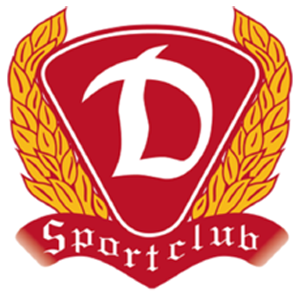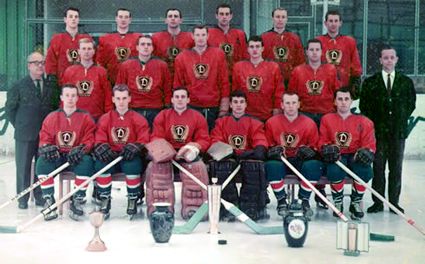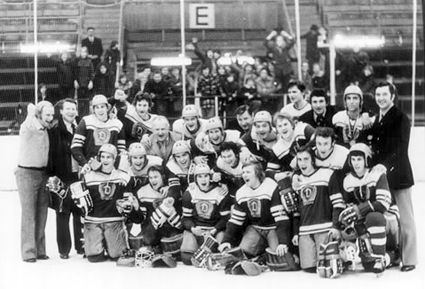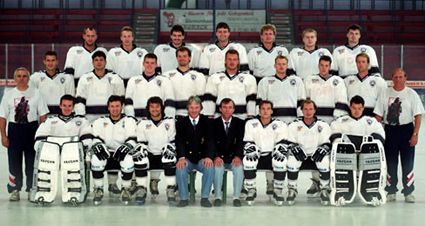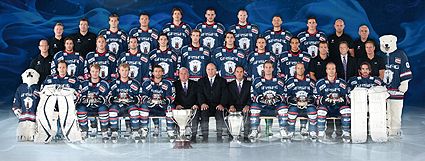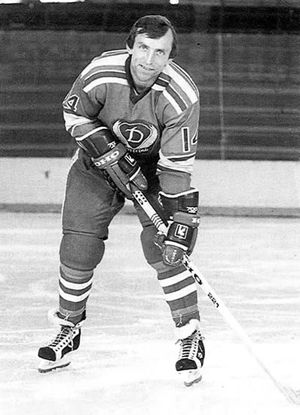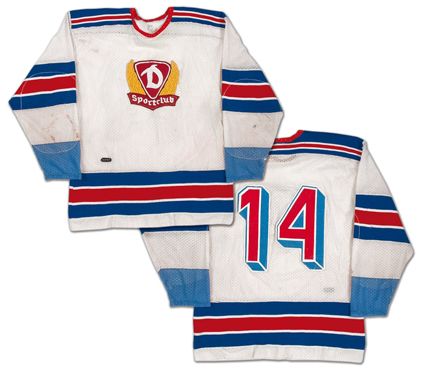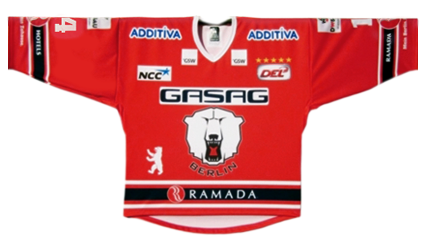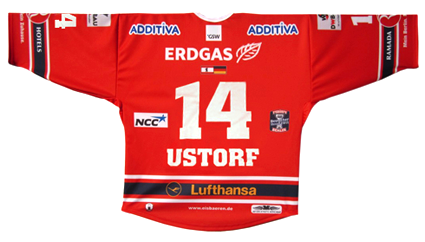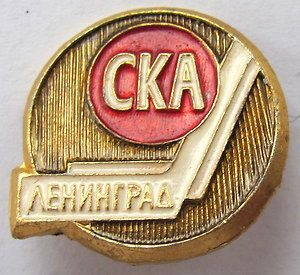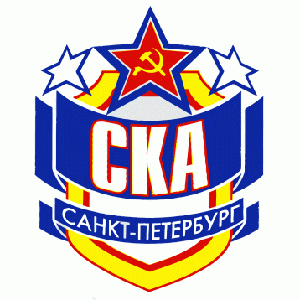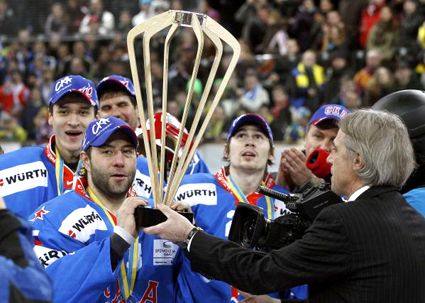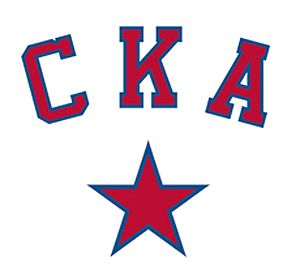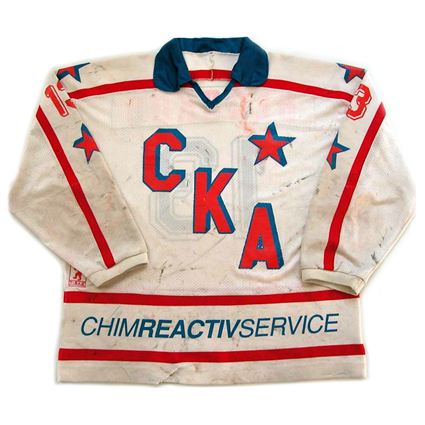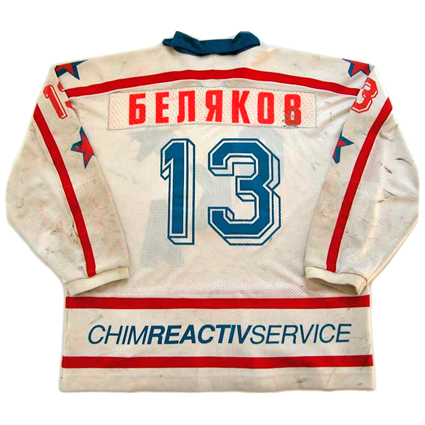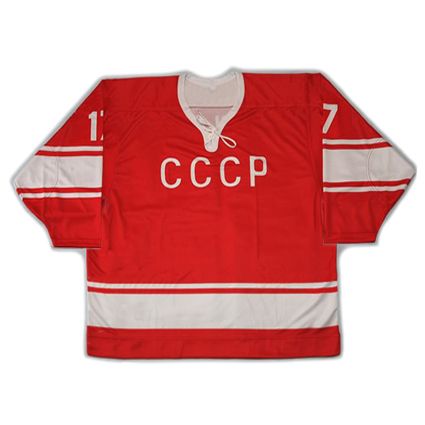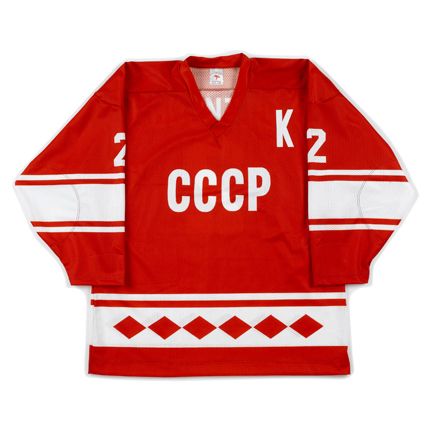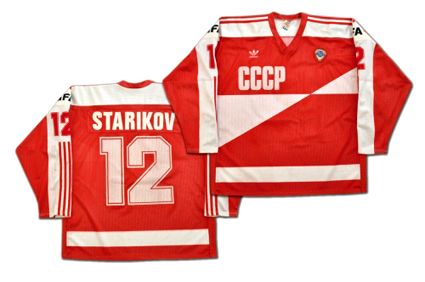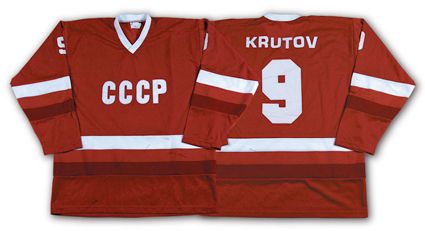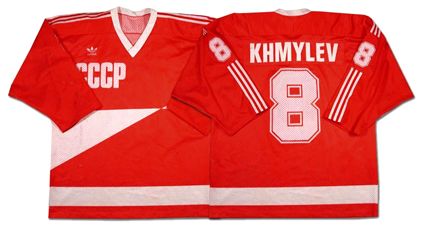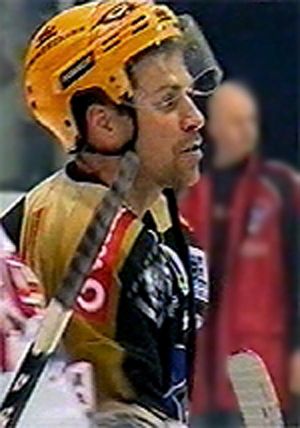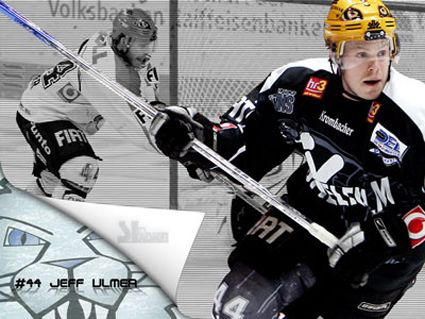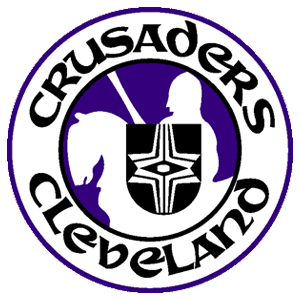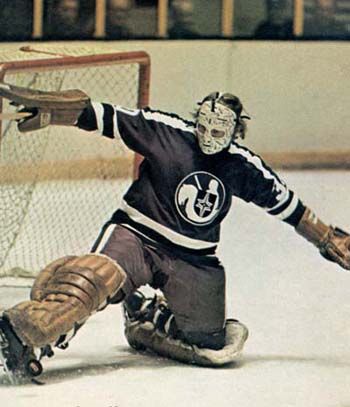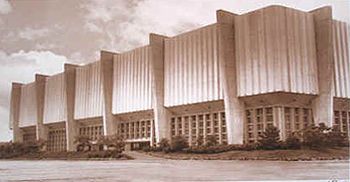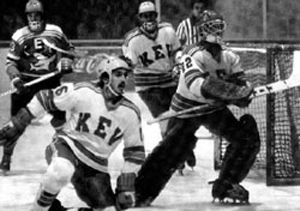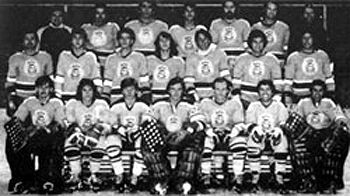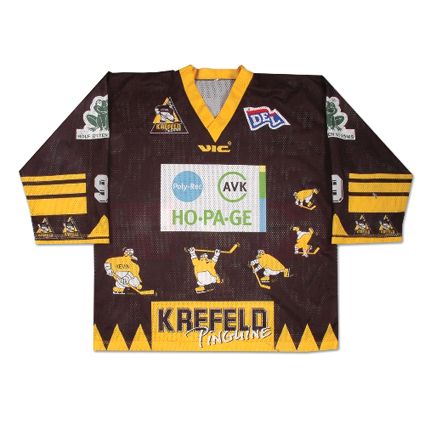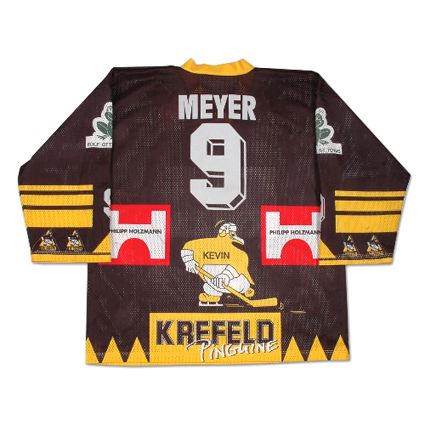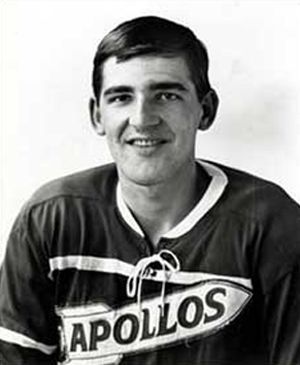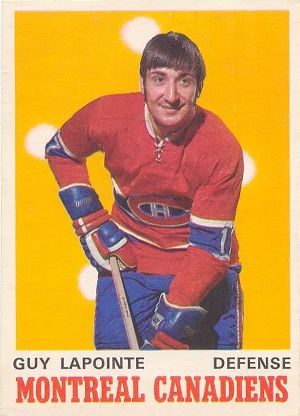Saturday, July 14, 2012
1981-82 SC Dynamo Berlin Dietmar Peters Jersey
July by the Numbers travels behind the Berlin Wall for jersey #14.
The Sports Club Dynamo Berlin was founded in 1954 and was a training center for the sports club of the Ministries of Police and State Security, more commonly referred to as the Stasi secret police, the German equivalent of the Soviet KGB. One of the clubs formed as part of the sports club was a hockey team, known as SC Dynamo Berlin.
They competed in the East German Oberliga, as Germany had been divided into the Federal Republic of Germany (West Germany) and the German Democratic Republic (East Germany) in 1949 following World War II.
Dynamo Berlin would compete for 18 seasons before winning their first championship at the conclusion of 1965-66, breaking the dominance of SG Dynamo Weißwasser, who had won 15 consecutive titles in the 18 year history of the league up to that point.
Dynamo Berlin would then win the next two titles in 1967 and 1968 to complete a hat trick of championships.
Three seasons later, the Oberliga would be reduced to a mere two clubs, SC Dynamo Berlin and SG Dynamo Weisswasser, from 1970-71 through the demise of the league with the reunification of East and West Germany in 1990.
At it's peak, the East German Oberliga had eight teams as recently as 1968-69, but hockey was no longer a priority in East Germany and the league shrank to four teams in 1968-69 and 1969-70 before funding for all but the two surviving clubs was discontinued abruptly in 1970, reducing the league to just two teams, the smallest ice hockey league in the world.
The thinking at the time in East Germany was that following it's last place finish in hockey at the 1968 Olympics, the country should focus on individual sports, as a single track and field athlete, swimmer or speed skater could produce multiple gold medals at the Olympics, while team sports like water polo or hockey required many players, special facilities (such as pools and skating rinks) and special equipment all resulting in higher operating costs - all for the sake of winning just a single medal. This thinking resulted in ice hockey being relegated to Class 2 status by the East German sports federation. The result was East Germany never appearing in another Olympic hockey tournament and the immediate reduction in funding for it's domestic hockey league.
With a 50-50 chance at the championship in the two team league, which survived the funding cuts only because the head of the Stasi, Erich Mielke, was a an avid hockey fan, Dynamo Berlin won five titles from 1976 to 1980 and another seven in a row from 1982 through 1988 for 12 out of a possible 13.
The 1975-76 Dynamo Berlin team which started their dynasty of 12 titles in 13 seasons
With the reunification of Germany in 1990, both Dynamo Berlin and the renamed PEV Weisswasser were assigned to the 1. Bundesliga, the highest level of hockey in Germany, with Dynamo Berlin being renamed EHC Dynamo Berlin.
The level of play demonstrated by the former West German clubs proved to be too much for Dynamo Berlin and PEV Weisswasser, as they were forced to meet to determine which club would be relegated to the lower 2. Bundesliga for the 1991-92 season, with Dynamo Berlin coming out on the short end by being swept in three straight.
The team was struggling financially while adapting to life in capitalist, reunified Germany and often finished near the bottom of the standings, but managed to stave off relegation while serving as a rallying point for it's fans from the former East Germany, who were regularly taunted by former West German fans, who never failed to portray themselves as more cosmopolitan and more superior than the "have-nots" from the East. The fans of Dynamo embraced the team and their East German roots, chanting "Ost-Ost-Ost Berlin" (East-East-East Berlin) at games, refusing to be made to feel bad about who they were and where they came from.
It would only take one season of play for Dynamo Berlin to earn their way back to the top level, which began a new era for the club, as prior to play in the 1. Bundesliga for 1992-93, the team was renamed ECH Eisbären Berlin (Berlin Polar Bears) to distance itself from the name Dynamo, which only served to remind everyone, sponsors in particular, of it's Stasi past,
The first team officially named Polar Bears, the 1993-94 club, although they had been using the polar bear logo for a couple of years already
In 1994, the Bundesliga was abolished and replaced by a new league, the Deutsche Eishockey Liga (DEL), with Eisbären being one of the 18 founding members. In 1995, the landscape of professional sports in Europe was changed forever with a ruling that granted players free movement from not only one team to another, but to any other country when their contract expired. Eisbären took full advantage of the new rules and replaced nearly their entire roster with veteran European players, ushering in a new era of competitiveness.
The finished in third place in 1996-97 and advanced to the DEL playoffs for the first time. The following season they made it to the DEL Finals and also participated in the Continental Cup, finishing second and in 1998-99, they finished third in the European Hockey League.
They team was purchased by the Anschutz Entertainment Group (AEG, owners of the Los Angeles Kings of the NHL, Djurgårdens IF in Sweden and the Hamburg Freezers, also of the DEL) in 1999, which gave them a strong financial footing. Their popularity rose, and sellouts became the norm in the early 2000's. After missing the playoffs for two seasons, the club reached the quarterfinals in 2002, the semifinals in 2003 and reached the finals in 2004.
With the 2004-05 NHL season lost due to the lockout, the Polar Bears took the opportunity to sign NHL veterans Erik Cole, Nathan Dempsey and Olaf Kölzig, who helped the club capture their first championship in the reunified Germany when they defeated the Mannheim Eagles in the finals.
That success was a springboard for a new era of dominance, as the club has now won DEL championships in 2006, 2008, 2009, 2011 and 2012, their sixth in eight years.
The 2011-12 DEL champions, Eisbären Berlin
Their run of success allowed the club to move out of the 4,695 capacity (3,000 of which were standing room) Sportforum Hohenschönhausen on the eastern side of the city, their home since 1963 and derisively known as "The Corrugated Tin Palace", a holdover from the communist past, and into the brand new O2 World arena in 2008, which boasts a seating capacity of 14,200 and is in the city center, practically on the site of the Berlin Wall, it's site chosen by AEG for it's neutral location in order to attract fans from both sides of the city - a far cry from the days of a two team league endlessly playing each other, and only each other, in front of a meager 500 fans.
The central location of the arena was also essential for uniting the fans in all of Berlin following the collapse of the rival Berlin Capitals, which was founded in 1983 and ran into serious financial problems in 2002 and folded in 2005, leaving the Polar Bears as the only team in Berlin, in addition to being the only DEL team located in the former East Germany.
Today's featured jersey is a 1981-82 SC Dynamo Berlin Dietmar Peters jersey from the club's first championship of their record setting seven consecutive titles won throughout the 1980's. This jersey is essentially a duplicate of the white New York Rangers jersey, first introduced back in 1951 and used through 1976 before being brought back again permanently in 1978-79, only with the obvious use of a Dynamo Sportclub crest and the distinctive European block font with a drop shadow for the numbers.
Dietmar Peters, a defenseman, began play with SC Empor Rostock and when that club was dissolved with the reduction in the number of clubs to two, he joined SC Dynamo Berlin in 1971, continuing to play for them for 15 seasons, which included winning nine championships.
He came out of retirement in 1999 to play for the Saale Bulls in the lower ranks of German hockey at the age of 49, playing an additional three seasons before his second retirement. He also played for the national team 315 times, the most appearances in East German hockey history.
Bonus jersey: Today's bonus #14 jersey is a 2011-12 Berlin Polar Bears Stefan Ustorf jersey. This red jersey was the team's alternate jersey in 2011-12 to go with their black home jersey and their white away jersey and illustrates the evolution of hockey jerseys over the last 30 years when compared to it's 1981-82 predecessor, which was completely devoid of player names or sponsorship logos so prevalent in European hockey today.
Today's video section is the fans of Eisbaren Berlin chanting Ost-Ost-Ost Berlin at a game at the new arena.
Labels:
Dynamo Berlin
Friday, July 13, 2012
1995-96 SKA Saint. Petersburg Viktor Belyakov Jersey
July by the Numbers stays in the Soviet Union for jersey #13.
Having been founded in 1946, Sports Club of the Army Leningrad has competed at the highest level of Soviet and Russian hockey in every season of it's existence, save for three.
SKA Leningrad were relegated for the 1947-48 season, but earned an immediate promotion back to the top level in their first try. Their return to the top level did not go well, and the club was once again demoted to the second division, and again won the right to return to the top division for 1950-51. This time they were successful in staying up, and remained in highest level for the next 40 years.
An old badge for HC SKA Leningrad
Their first taste of success came in 1968 when they were a finalist for the USSR Cup, a season long knockout competition which ran concurrently with the league regular season. The club earned their first hardware in 1970, when they won their first Spengler Cup, defeating the Czechoslovakian team Dukla Jihlava.
The team repeated their Spengler Cup success with another victory over Dukla Jihlava in 1971 and then completed arguably the best season in club history with a bronze medal in the Soviet Championship League and a runner up finish in the USSR Cup.
Their next success would arrive with their third Spengler Cup victory in 1977 at the expense of Dukla Jihlava once again.
SKA Leningrad's next success in the Soviet Championship League came with another bronze medal after the 1987 campaign.
That success would have to suffice for some time, as the political upheaval which arrived with the dissolution of the Soviet Union would affect the club's finances and resources as the changes in Russian society and it's sporting landscape sorted themselves out over the early part of the 1990's. This instability saw the team relegated for only the third time in it's history, as they were relegated following the 1990-91 season.
Another affect the breakup of the Soviet Union had on the team was the name of their home city Leningrad changing back to it's historic, original pre-1914 name of Saint Petersburg in 1991. From then on, the club would now be known as Hockey Club SKA Saint Petersburg.
They team would rebound from their relegation in short order, returning to the top level after just one season. The league they returned to in 1991-92 was the renamed and reorganized International Hockey League, which would be renamed Russian Super League in 1999 when membership was once again open to teams from outside of Russia, such as those from Belarus and Latvia.
SKA Saint Petersburg would compete in all seasons of the RSL from 1996-97 through 2007-08 and then join the newly created Kontinental Hockey League for it's inaugural 2008-09 season and win the Bobrov Division in 2009-10 with Maxim Shushinski finishing second in scoring by a single point with 65 points, followed by teammate Alexi Yashin with 64.
The following October, SKA defeated the Carolina Hurricanes of the NHL in an exhibition game in Saint Petersburg by a score of 5-3.
Tuomo Ruutu of Carolina tries to score on SKA goaltender
Evgeni Nabokov during their 2010 exhibition game
Their noteworthy season continued in December with the club defeating Team Canada to capture it's fourth Spengler Cup on New Year's Eve, five weeks before the club hosted the KHL All-Star Game at the Ice Palace, their home rink built for the 2000 World Championships.
Maxim Shushinsky accepting the 2010 Spengler Cup
The Ice Palace holds 12,300 fans and has hosted the IIHF European Champions Cup from 2005 to 2008. In 2011-12, SKA averaged 10,126 fans, becoming the first Russian club to average over 10,000 fans per game in a season. SKA also placed 6th overall in all of Europe behind teams from Switzerland, Belarus, two from Germany and Sweden.
Today's featured jersey is a 1995-96 SKA Saint Petersburg Viktor Belyakov jersey. Despite having been broken up in late 1991, this jersey still carries influences from the Soviet Union with it's spartan design and prominent red stars.
The thin numbers with a clear drop shadow is classic early 1990's European style, but what really screams "European" about the jersey is the fold over dress shirt collar, more commonly found in Scandinavian countries. A sign of the changing economics of the times is evidenced by the sponsorship found along the waist, both front and back, which would only grow to be more prominent as time passed.
Fortunately for you our readers, the internet has yet to be able to transmit odors, because there is nothing in this world that smells quite like an old Russian game worn jersey, a remarkable stench that packs a pretty mean punch!
Belyakov was a center who played for SKA beginning in 1988-89 when the city was still known as Leningrad and remained with the club for 10 seasons through the change to Saint Petersburg, and the Soviet League evolving into the International Hockey League, the Russian Hockey League and the Russian Super League. He finished his career with two additional seasons with Sibir Novobirsk, helping them earn promotion from the Russian second division to the Super League for his final season of 2002-03.
Today's video segment is an lengthy interview, in English, with SKA's Alexi Yashin (and his wife) at the 2010 Spengler Cup that we feel is worth your time.
This next video is a report on SKA Saint Petersburg from just prior to the 2010-11 season.
Labels:
SKA Leningrad,
SKA Saint Petersburg
Thursday, July 12, 2012
1986 Soviet Union Sergei Starikov Jersey
July by the Numbers takes us back to the days of the Soviet Union for jersey #12.
The Soviet Union joined the world of international hockey back in 1951 and made their world championship debut in 1954, winning gold their first time out, only wearing blue sweaters, not the red ones for which they would become famous for.
A 1954 Soviet Union National Team sweater
For the majority of their existence, the Soviets would wear red sweaters of a minimalist style with basic sleeve and waist striping adorned with a simple CCCP across the front. No fancy fonts, no italics, no additional colors. All very utilitarian and simple in nature, just enough to identify the team on the ice and nothing more.
As late as the Olympics in February of 1976 they were still wearing the same simple jersey style as they had used as far back as the 1964 Olympics.
In September of 1976, they debuted a new set of sweaters, still with the same basic striping pattern, only now decorated with repeating diamond shapes around the waist - a radical departure for the Soviets. This style would serve the Soviets well, including several tours of North America in the Super Series games against NHL clubs, the 1976 Canada Cup, the 1979 Challenge Cup, the 1980 Olympics, the 1981 Canada Cup and another tour of North America in 1983.
The Soviet Union's signature diamond stripe
jerseys of the late 70's and early 80's
They would revert to a very basic style with a pair of simple stripes in white and a nearly invisible dark red on their red sweaters for the 1984 Olympics and later the 1984 Canada Cup. The white home jerseys were more successful, with their pair of extremely similar in tone red stripes against white.
The more successful home white version of the 1984 Soviet Olympic jersey
photo courtesy of Classic Auctions
All that changed with the rise of sports marketing in 1985 when Adidas became the supplier to all the teams at the IIHF World Championships. While the jerseys employed the same basic sleeve and waist stripes of the 1976 Olympic jerseys, the iconic three stripe pattern signifying the Adidas brand now ran down the full length of the arms, while sponsorship patches from the Belgian film manufacturer AGFA signaled a new era of commercialism in international hockey.
Slava Fetisov wearing an Adidas jersey at the 1985 World Championships
The next and boldest step arrived in 1986 at the World Championships in Katowice, Poland in the form of today's featured jersey, a 1986 Soviet Union Sergei Starikov jersey, as the Soviets arrived with a striking new design unlike anything in the history of their national team, dating back now 35 years.
Attention getting enough was the prominent white stripe running down each arm, which served as a background to highlight the Adidas stripes to an even greater degree than the previous style, but what really made this a stunning departure from any prior Soviet jersey were the bold, asymmetrical white triangles which simply screamed "LOOK AT ME!" in a way no Soviet jersey had ever dared before.
The "double triangle" look was completed with CCCP in a bold, modern font, while similar to the previous style, now tightly spaced in a way that made it appear much more aggressive. A true high point in the history of international jerseys, and brought to you by a no more unexpected and shocking source than the normally staid Soviet Union!
photo courtesy of Classic Auctions
This exact jersey style had an all too brief lifespan, being worn only for the notorious 1987 World Junior Championships in December of 1986, stretching into January of 1987, when on January 4th, the Soviets and Canadians engaged in the bench clearing brawl in the final game of the tournament, now named the "Punch-up in Piestany".
Without warning, the Soviet Union, then returned one more time to the white and (nearly invisible) dark red striped style previously worn in the 1984 Olympics for Rendez-vous '87, the two game series between the Soviet Union and the NHL All-Stars, which replaced the customary NHL All-Star Game that year.
1987's surprise reprise of the 1984 Soviet Union Olympic jersey
photo courtesy of Classic Auctions
Two months later in April of 1987, a new version of the "double triangle" jersey had appeared for the 1987 World Championships which sadly had the white sleeve stripes now removed in the style of the first Adidas jerseys introduced at the 1985 Worlds, but with the asymmetrical, bold triangles still in place but with the magic of the 1986 World Championship style now gone.
After seeing the downright flashy debut of the "double triangle" style with it's white sleeve stripes, this return to a more spartan look for the stoic Big Red Machine was a let down, as it lacked the flash of previous version. This style would be used once again in September of 1987 during the 1987 Canada Cup.
The Soviet Union's 1987 Canada Cup jersey
reels in the flash of the previous style
photo courtesy of Classic Auctions
This would be the last hurrah for this family of jerseys, as the Finnish company Tackla would take over from Adidas from the 1988 World Juniors on, bringing in a whole new family of jerseys for the Soviet program as they remained their supplier through the rest of the history of the Soviet Union and beyond, into the earliest days of the Russian National Team in 1992.
Our video section today illustrates the "double triangle" style, first with footage from the 1985 World Championships, the first with Adidas stripes down the sleeves, but still the basic 1976 Olympic striping pattern.
Ironically, the low point in Soviet hockey history came while wearing the high point in their jersey design, the Punch-up in Piestany at the 1987 World Junior Tournament.
Finally, rare footage from the 1987 World Championships, where the Soviet jerseys took a step back from the bold jerseys of 1986, as the arms no longer had the full length white stripes.
The final appearance of the "double triangle" style at the memorable 1987 Canada Cup.
Labels:
Soviet Union,
Soviet Union Jersey History
Wednesday, July 11, 2012
1999-00 Frankfurt Lions John Chabot Jersey
July by the Numbers returns to Germany for jersey #11.
Founded in 1959 as part of the Eintracht Frankfurt sports club, the Frankfurt Lions, the hockey club became it's own separate entity in 1991 and was renamed Frankfurter ESC Die Löwen (The Lions). When the DEL came into being in 1994, the club name was simplified to the Frankfurt Lions.
For their first DEL season, the Lions finished mid-pack in 10th out of 18, improving to 8th in 1995-96. A format change for the league in 1996-97 saw them finish 10th in Phase I of the season and defend their place in the DEL by defeating Ratinger Löwen in three straight games in the relegation playdowns.
A change in ownership over the summer saw new logos and colors adopted and once play began, they improved in 1997-98 to a 4th place in Phase I, before placing second in Phase II of the regular season. In the playoffs, they downed the Hannover Scorpions 3 games to 1, but were swept by defending and eventual champions Adler Manheim.
The following season they finished 4th in the regular season and won their first round playoff series in the full five games before again being knocked out in the Semifinals. 1999-00 saw a 7th place finish and a first round playoff exit before a 10th place finish in 2000-01 followed by 11th place the following season.
The 2002-03 season was a forgettable one for the Lions. They placed 13th out of 14 clubs, which forced them into the relegation playoff against the dreadful Schwenninger ERC Wild Wings, who trailed even the Lions by 25 points in the standings. Shockingly, the Wild Wings defeated the Lions 4 games to 2 to mark the Lions for demotion. The Lions were spared when the Wild Wings entered bankruptcy and had their DEL license cancelled, allowing the Lions to remain in the league after all.
Given their new lease on life, the Kions roared up the standings, raising their win total from 14 to 26 and a 5th place finish, retiring them to the playoffs thanks to league MVP and leading scorer Patrick Lebeau's 69 points. There, they knocked off the favored Cologne Sharks in six games before doing the same to the Hamburg Freezers 3 games to 2, as oddly, the first round is a best of seven, while the semifinals and finals are only a best of five. They then made the most of their second chance after being destined for relegation 12 months earlier when they defeated the Berlin Polar Bears 3 games to 1 to capture the 2004 DEL championship.
The Frankfurt Lions celebrate their 2004 DEL championship
With the 2004-05 NHL season cancelled, the Lions were able to add NHL regulars Stéphane Robidas of the Chicago Blackhawks and Doug Weight from the St. Louis Blues to their roster in mid-season. which aided the Lions in finishing first overall for the first time during the regular season with a team record 103 points from a 35-17 record. While they won their first round series, they were upset in the semifinals, costing them a chance to defend their championship.
Doug Weight while with the Lions
The club dropped to a 9th place n 2006 and came 8th in 2007, winning a preliminary round playoff series before dropping out in the first round. Success returned in 2007-08 with a 4th place finish and a quarterfinal playoff round win before dropping hard fought five game series to the Sharks, with four of the five games decided by a goal, two of which went into overtime.
Turmoil for the club began in August of 2008 when team co-founder and principal owner Gerd Schröder died at the age of 49 after having been in a coma following a stroke earlier in the year.
2008-09 had the Lions finishing 9th and then felled in the preliminary round of the playoffs. 2009-10 again saw the Lions among the league's elite teams, finishing second overall with 98 points, led by DEL scoring champion Canadian Jeff Ulmer's 37 goals and 74 points in 56 games, only to be eliminated in the quarterfinals 3 games to 1.
Jeff Ulmer
Sadly, their success on the ice was not reflected in the club's finances, and they were forced to cease operations following the 2010 playoffs, bringing to an end 51 years of hockey.
In the history of the club, Lebeau was their all time leading scorer with 307 points, 111 goals and 196 assists, tops in all three categories.
All-time leading scorer Patrick Lebeau
hoisting the 2004 championship trophy
Today's featured jersey is a 1999-00 Frankfurt Lions John Chabot jersey. While a sponsored jersey, this style still manages to maintain the Lions identity, with their Lion head logo still prominent on the front of the jersey despite being overshadowed somewhat by the Arcor logo above it.
On the back, in typical European style, the player name is below the numbers, with the PlayStation name being given top billing across the shoulders.
The jersey is very busy visually thanks more to the ten black, silver and red stripes across the front, and would be better off without the pair of black stripes behind the lion's head.
One very unique feature of the jersey is the skyline of Frankfurt appearing in the sleeve stripes, a simple and effective way to make the jersey a memorable one.
John Chabot was an NHL veteran, having played with Montreal, Pittsburgh and Detroit from 1983 to 1991 before moving to Germany where he played for nine seasons, three of which were with the Lions, where his veteran experience led to him being named team captain.
Today's video section is Lebeau scoring for the Lions scoring against the Polar Bears in the 2004 DEL finals.
Labels:
DEL,
Frankfurt Lions
Tuesday, July 10, 2012
1975-76 Cleveland Crusaders Kyle Moffat Jersey
July by the Numbers returns to the United States for a stop in Cleveland for jersey #10.
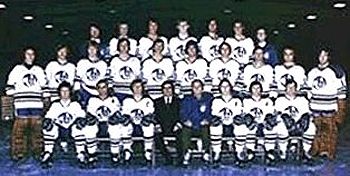
After purchasing the Cleveland Barons franchise in the AHL, owner Nick Mileti , who also owned the NBA's Cleveland Cavaliers, attempted to buy a franchise in the NHL. When that plan did not pan out, he instead bought a franchise in the newly created World Hockey Association. Unlike the franchises on Boston (New England), New York, Philadelphia, Chicago, Los Angeles and Minnesota, the Crusaders did not have to compete directly with an NHL club in their own back yard.
In addition to being the only show in town, the Crusaders made a splash by signing defenseman Paul Shmyr away from the California Golden Seals but really grabbed the headlines when the lured goaltender Gerry Cheevers away from the defending Stanley Cup champion Boston Bruins in arguably the most noteworthy signing by the WHA after Bobby Hull and Gordie Howe.
Gerry Cheevers
The club found a home at the aging Cleveland Arena, which was built back in 1937 and seated less than 10,000 fans. Backed by the strength of Cheevers goaltending, the Crusaders had a fine first season, finishing second in the Eastern Division with a 43-32-3 record while allowing the fewest goals against and averaging 5,287 fans per game. In the playoffs, they swept the Philadelphia Blazers in their final games in Philadelphia, but were dispatched easily by the New England Whalers 4 games to 1.

The inaugural Cleveland Crusaders of 1972-73
Still playing in the Cleveland Arena in 1973-74, the Crusaders slipped a bit in the standings, winning 37 games to a third place finish in their division, but attendance was up nearly 20% to 6,212. For the playoffs, the Crusaders faced the Toronto Toros, who had relocated at the end of the previous season from Ottawa, and the Toros ended Cleveland's season in five games.
Paul Shmyr battles for the Crusaders
For the Crusaders third season, the club debuted a new home, the Richfield Coliseum, 25 miles south of downtown. Their new arena had room for 18,500 fans and was one of the first with new luxury boxes. While it was rather far from Cleveland, it was hoped that fans from Akron to the south would also be willing to make the drive north to the new arena.
Despite dropping to a 35-40-3 record, the Crusaders finished second in the Eastern Division and were the final qualifier for the playoffs. As the lowest seed, they drew the #1 overall team, the Houston Aeros who had little trouble closing out the Crusaders 4 games to 1.
Although attendance rose with the move to Richfield, up to 6,931, it was certainly less than hoped for, as issues arose with the Coliseum. It's single concourse, which served both levels, quickly became crowded and many fans were often late arriving to games due to the two-lane rural highway which led to the arena, especially on days when the snow came in off Lake Erie, backing up traffic several miles. Additionally, the luxury boxes were at the highest level of the arena, making them actually the worst seats in the house.
The Richfield Coliseum
For the 1975-76 season, Mileti sold the club to Jay Moore, but it was more of the same for the Crusaders on the ice, as they posted a nearly identical 35-40-5 record while finishing a narrow second to the Indianapolis Racers for the Eastern Division title as attendance sank to 6,356. The signs of real financial problems began to show themselves, which led to Cheevers leaving the club in mid season to return to the Bruins. The club then faced off against the Whalers in Preliminary Round of the playoffs, getting dumped in three straight games, bringing and end to the Crusaders after four seasons.
Moore then sold the club back to it's original owner Mileti, but for the 1976-77 season, it was announced that the NHL's California Golden Seals were moving to Cleveland to become the Barons, and would be setting up shop at the Coliseum. Knowing the city could not support two professional clubs, Mileti's proposed sale, which would have moved the team to Florida, fell through and the franchise eventually was relocated to St. Paul, where it became the second incarnation of the Minnesota Fighting Saints.
Today's featured jersey is a 1975-76 Cleveland Crusaders Kyle Moffat jersey. The Crusaders jerseys can be divided into two periods, with their first two seasons sporting three stripes in the "Northwestern" pattern and the last two seasons with a single bold stripe on the arms and waist as seen on today's featured jersey.
photo courtesy of Classic Auctions
Today's video section begins with footage of the Crusaders in action, where the narrator insults your intelligence by explaining what a "faceoff" is. Note the three stripe pattern on the Crusaders jerseys.
Pay no attention to the fact that there's chicken wire fencing at the end of the rink!
Want to watch Cheevers eat lasagna with his family and sign some mortgage papers? Sure you do. Here's an in-depth 21 minute profile of Cheevers which finally gets around to hockey after somewhat excruciating, unedited 13 minutes...
Labels:
Cleveland Crusaders
Monday, July 9, 2012
1996-97 Krefeld Penguins Jason Meyer jersey
July by the Numbers continues and it's back across the Atlantic for jersey #9.
Founded in 1936 as Krefelder Eislauf-Verein 1936 e.V. (KEV for short), the club, after returning after a suspension of play during World War II, won their first championship on March 12, 1952.
After struggling near the bottom of the Bundesliga for a decade and a half, thanks in part to competing with a local rival club, things really began to look up for KEV with some key acquisitions and the demise of the other Krefeld based club, KTSV Prussia in 1971.
Just as the club was knocking on the door of a title, in a shocking turn of events, ownership had overextended itself in previous seasons and the club's actual financial condition had not been accurately reported, all of which resulted in bankruptcy for KEV, which caused the German sporting authorities to revoke the team's franchise.
A new club, EHC Krefeld was formed in 1978-79, which started at the bottom of the German hockey ladder, playing in a regional league with junior players and older players, some of whom were lured back out of retirement. This club proved far stronger than their opposition, even posting a memorable 48-0 win!
The inaugural ECH Krefeld club
With the club now promoted up a level, many of the older players once again retired, their mission accomplished. New, younger players were brought in for the 1979-80 season, which resulted in a fine second place finish. Fate intervened however, as first place finisher Hamburg SV declined the opportunity to move up for financial reasons, moving EHC up the ladder once again.
When the 1980-81 season began, the club was now renamed Krefelder Eislauf-Verein 1981 e.V., reviving the name of the original club founded back in 1936. Their rise to the top division was slowed however, as the quality of competition was much stronger in the second division than it was in the third and fourth levels of the past two seasons.
The club endured for 11 seasons in the second division, and again flirted with financial problems and relegation on occasion, but persevered until the 1990-91 season, which began poorly with KEV at the bottom of the table. Bold moves were made to bring in Czech national team goaltender Karel Lang, as well as the high scoring Francois Sills and Peter Jedrus. With the revamping of the lineup complete, the wins soon followed and by the time the playoffs began, KEV had climbed to second place and their victory in the playoffs propelled the club, and once more the city of Krefeld, into the top level of the Bundesliga.
While their play on the ice was enough to keep KEV in the 1. Bundesliga, they once more faced bankruptcy in 1995, only this time a last minute reorganization allowed the club to retain it's license for the 1995-96 season, now reorganized as KEV Pinguine Eishockey GmbH, or Krefeld Pinguine (Krefeld Penguins). This was also the period of time when the Bundesliga gave way to the new DEL hockey league, ushering in a new era for German professional hockey, particularly with the ruling that made players all across Europe free agents when their current contracts expired, allowing a much greater freedom of movement for players previously unable to play in Germany.
After becoming the Krefeld Penguins and a member of the DEL, they regularly made the playoffs, reaching the postseason in five consecutive seasons. They missed the playoffs in 2001, but returned again in 2002.
While the club only managed a sixth place finish in 2002-03, the upset the DEG Metro Stars in five games before knocking out the #1 seeded Berlin Polar Bears 3-1 to reach their first ever finals despite the Polar Bears finishing 31 points higher in the regular season standings. There, they met the Cologne Sharks, the #1 overall seed. Krefeld won Games 1 & 2, but lost the next two, including Game 4 in overtime, which forced a deciding Game 5, which the Penguins won by a score of 3-1 to take the series and the championship 3 games to 2 to capture the first title in club history, second if you count the Penguins as a continuation of the first KEV club, founded back in 1936.
The Krefeld Penguins - 2003 DEL champions
During the regular season, Penguins Christoph Brandner (formerly of the Minnesota Wild) led the league with 28 goals, while teammate Brad Purdie was tops in assists with 41. Other notable names on the championship squad were future NHLer Christian Ehrhoff, Canadians and former NHLers Gary Shuchuk and Sandy Moger and the late Robert Müller in goal.
Today's featured jersey is a 1996-97 Krefeld Penguins Jason Meyer jersey. Worn shortly after the club changed their name to include the Penguins nickname, this attempt at a whimsical jersey crosses into the absurd, with with it's tumbling, celebrating penguins surrounding the main sponsor logo on the chest, which itself is an overly large, color-clashing obnoxious billboard.
Adding to the visual confusion is the main team logo of a penguin in a triangle, which is not only on the upper right chest, which would have been fine if they would have stopped there, but it is repeated in a smaller size around the cuffs, as if the five tumbling ones on the front of the jersey weren't enough already! Worse, the triangle shape is then repeated around the waist as well as another one on the cuffs for good measure. Here's an idea. If you want to repeat the team logo around the arms, how about not putting triple arm stripes of varying widths just above them to distract from them?
While we're at it, we also dislike the lousy way the team name is applied to the bottom of both the front and back, particularly the handwritten, juvenile "Pinguine" diagonally across the name of the city.
If the main sponsorship slapped on the front of the jersey like a bumper sticker wasn't bad enough, the back has a pair of bold red logos and the shoulders are adorned with winking green frogs, only adding to the mess that this jersey is!
Don't even ask us why the penguin on the right front, which is repeated larger on the back, has the name "Kevin" on it. We don't even want to know because it's certain to be stupid if we ever found out.
Later Penguins jerseys would have a certain style and flair, but this particular one is a collection of bad ideas lumped together all on one awful jersey - one with frogs and tumbling penguins, one of which is named Kevin.
Today's video section is a look at the history of the franchise in pictures and video, which captures the widely varying jerseys worn by the club in it's history, some good, some simply horrid.
Labels:
Krefeld Penguins
Sunday, July 8, 2012
1968-69 Houston Apollos Bob Ellett Jersey
July by the Numbers travels south for jersey #8.
Born during the hysteria of the Apollo space program, which began in 1963 to send men to the moon for the first time, the Houston Apollos were members of the Central Hockey League from 1965-66 to 1968-69.
They played their games at the Sam Houston Coliseum and were, oddly enough, a farm team of the far away and very, very French Montreal Canadiens. This led to some of the Canadiens prospects from Quebec finding themselves in a very foreign culture, while the fans in Houston were treated to seeing some of the finest prospects in the game, who would go on to rule the NHL from 1968 to 1979, winning 8 Stanley Cups in 12 seasons.
Andre Boudrias led the inaugural club in scoring with 73 points in 70 games as the team finished fifth out of the six teams, missing the playoffs by four points.
The 1965-66 Houston Apollos
Prior to the NHL expansion of 1967-68, minor league franchises enjoyed a certain level of stability during what was still the Original 6 era and it's limited job opportunities for players. This resulted in their top scorers from the season prior, Boudrais and Bill Inglis, returning, along with holdovers Bob Charlebois and Garry Peters, who made up four of their top five scorers in 1966-67.
The Apollos roster also boasted future stars Jacques Lemaire, Serge Savard, Carol Vadnais, Pat Quinn and Rogie Vachon in goal all learning their craft in the deep south. The influx of talent raised the Apollos to a 32-28-10 record, which earned them a third place finish and a spot in the CHL playoffs for the first time.
Serge Savard
The 1967-68 expansion doubled the size of the NHL, which resulted in a shakeup with the Apollos roster, which was led in scoring by Jude Drouin, who had 22 goals and 60 points, while Chris Bordeleau led the team in goals with 23. Ernie Wakely led the goaltending with 57 games while several future NHLers dotted the roster, including Garry Monahan, Bryan Watson, Ernie Hicke, Vadnais, Danny Grant, Micky Redmond and Claude Larose all going on to play 500 games or more in the NHL.
Hicke led the 1968-69 Apollos to the playoffs with a team leading 72 points, while newcomer Alain Caron had the most goals with 38. The big news was in goal, as the tandem of Phil Myre (53 games) and Tony Esposito (19) shared the crease. The other notable arrival on the club that season was defenseman Guy Lapointe, who would play for the Canadiens for the next 13 seasons.
Apollos graduate Guy Lapointe
While men touched down on the moon in July of 1969, the Apollos also took flight following the 1968-69 season, landing in Montreal where they became known as the Montreal Voyageurs, ending their four seasons in Houston, a move deemed necessary by the Canadiens due to travel costs, low attendance, poor dates in the arena and a lack of practice time operating the club in Houston.
Today's featured jersey is a 1968-69 Houston Apollos Bob Ellett jersey, a beautiful sweater clearly based on the home jersey of the parent Canadiens, as seen in the red shoulders and cuffs, blue numbers outlined in red and the lace-up collar, all traits shared with Montreal's sweaters.
While the Canadiens had a red stripe over a blue stripe around the waist, the Apollos had the color order reversed and the stripes much farther apart.
What really makes this jersey stand out is the fantastic crest of the two-color rocket with contrasting fins which contains the name "Apollos" in beautifully chain-stitched lettering. Simply gorgeous!
Labels:
Houston Apollos
Subscribe to:
Posts (Atom)

